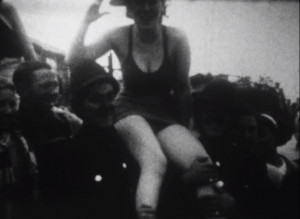
"The excitement of a 1937 holiday starts with the packing of Arthur J. Dawson's initialled suitcase and the train ride from Saltash to Hemsby in Norfolk. Station staff wait to help passengers transfer their luggage to the wooden chalets of Hemsby Holiday Camp. Organised entertainments include following behind a carload of musicians including accordionist, exercising in swimsuits on the beach, silly sports and getting messy with flour and water." (BFI database)
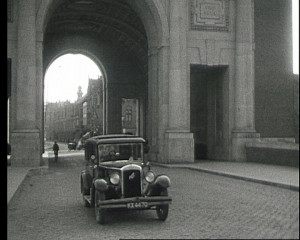
(Reel 1) - "First in a series of eight film reels recording Eustace and Eunice Alliott’s trip to and from the Oberammergau Passion Play in 1930, by way of a motor tour through Belgium, Luxembourg and the Rhine, before travelling further south to northern Italy, Liechtenstein and Switzerland, returning to London via Germany and Belgium. The first reel in this series records details of Alliotts' journey through Belgium and Luxembourg. Scenes include: visits to war memorials and observations of activities of local inhabitants. The visits to war memorials notably emphasise connections or interests that Eustace Alliott might have had or felt towards the sacrifices made by engineers or men from Lancashire. Scenes include: the Alliotts' car being loaded on to a ferry at Dover; shots of Ypres, notably the ruins of the Cloth Hall, the Menin Gate and market scenes near the Cloth Hall; visits to war memorials near Ypres, including Hill 60, Zillebeke, the Tyne Cot cemetery and the church at Passchendaele; the journey through Belgium including visits to Courtrai, Tournai, Mons and Namur, where the Alliotts' record celebrations of the centenary of Belgian independence; the journey by the Rivers Sambre and Meuse including their visits to Old Dinant and Chateau de Walzin; and time spent in in the gardens, streets and alleys of Luxembourg. Shots at Belgian war memorials include: a visit to the Hill 60 war memorial, where Eunice, along with members of the Farnham girl guides, inspect a concrete bunker; walk through and inspect a trench at Zillebeke, including a shot of the trench and abandoned munitions (trench now filled in, see http://www.ww1battlefields.co.uk/flanders/hill60.html); a visit to the Tyne Cot cemetery where Eunice inspects the inscription at the base of the Great Cross, including a clear shot of the inscription that has since been corrected (it reads captured by 2nd Australian Division [now corrected to 3rd Australian Division] 24 October 1917); at Tyne Cot Eunice walks past and looks at the Tyne Cot Memorial to the Missing; there is a shot of a headstone of one of the unidentified servicemen of the Royal Engineers; by the side of a road Eunice retrieves a discarded helmet; there is a shot of the Passchendaele church window memorial to British dead from “Duchy of Lancaster”. Shots at Namur for the centenary celebration of Belgian independence include: a procession of soldiers and dignitaries; Eunice with members of a Pierrot troupe, including shots of the troupe in a street procession." (EAFA Database)
(Reel 2) - "Second in a series of film reels recording Eustace and Eunice Alliott’s trip to and from the Oberammergau Passion Play in 1930, by way of a motor tour through Belgium, Luxembourg and the Rhine, before travelling further south to northern Italy, Liechtenstein and Switzerland, returning to London via Germany and Belgium. The second reel in this series records details of Alliotts' journey from Trier along the Moselle and Rhine river valleys [through the demilitarised area of Germany established by the Treaty of Versailles] to Bensheim. Scenes include: tourist attractions and observations of activities of local inhabitants. Shots of tourist attractions include: historic monuments in Trier; a visit to a Traben vineyard; castles along the Moselle and Rhine valleys; the Wilhelm I monument in Koblenz. Shots of local activities include: the market places in Trier and Bernkastel; agricultural labourers in the Moselle valley transporting hay; women and children bleaching linen by the side of the river in Bernkastel; agricultural labourers using ferries near Traben and fruit being picked along the road; river traffic on the Rhine at Koblenz with particular emphasis on the operation of a bridge consisting of boats. The reel concludes with a record of the Corpus Christi street celebrations in Bensheim. Many of the scenes include Eunice Alliott, who walks or drives into shot, or interacts with local inhabitants, or perhaps has persuaded individuals to pose for the camera, such as children at the Roman Basilica in Trier and a two man band in Stoltzenfels." (EAFA Database)
(Reel 3) - "Third in a series of film reels recording Eustace and Eunice Alliott’s trip to and from the Oberammergau Passion Play in 1930, by way of a motor tour through Belgium, Luxembourg and the Rhine, before travelling further south to northern Italy, Liechtenstein and Switzerland, returning to London via Germany and Belgium. The third reel in this series records details of Alliotts' journey from Heidelburg through the Neckar valley and Bavaria to Oberammergau, including shots of Oberammergau and the surrounding mountains. Scenes include: visits to historic monuments and tourist attractions as well as observations of the activities of local inhabitants. Notably, the film reel includes a day out with unidentified friends in Heidelberg and perhaps inadvertently a shot of the presence and activities of the national socialist party in and near Heidelberg.
Shots of tourist attractions and historic monuments include Heidelberg Cathedral and square, including a building with the sign ‘National Sozialistische Deutsche Arbeitespartei’; Heidelberg castle; river cruise boats at Neckargemünd; Ulm cathedral; and as the Alliotts' approach Oberammergau shots of the landscape. Shots of the activities of local inhabitants include: children playing by the river at Neckargemünd; a youth rambling group in the Neckar Valley; street scenes in Neckarsulm and a fair outside Ulm cathedral; street scenes in Oberammergau, highlighting the numbers of tourists in the village for the passion play. Many of the scenes include Eunice Alliott, who walks or drives into/ out of shot, such as watching a steam tug on the Neckar or admiring the view at Schongau or leaving Neckarsulm. Both Eustace and Eunice Alliott appear in shot during the picnic at Heidelberg. Notably Eustace Alliott appears in shot at Heidelberg, Schongau and possibly once driving the Austin Sixteen. Eustace Alliott also features in the section following the intertitle ‘Part II – Oberammergau, June 1930’, appearing mountain walking near the Kofel mountain and mountains overlooking Oberammergau." (EAFA Database)
(Reel 4) - "Fourth of a series of film reels recording Eustace and Eunice Alliott’s trip to and from the Oberammergau Passion Play in 1930, by way of a motor tour through Belgium, Luxembourg and the Rhine, before travelling further south to northern Italy, Liechtenstein and Switzerland, returning to London via Germany and Belgium. The fourth reel in this series records details of Alliotts' stay in Oberammergau, focusing on the 1930 Passion Play and their interaction with key members of the cast. Shots include: women washing and drying laundry away from the main streets; the Alliotts' accommodation and host; crowds outside the theatre; official photographs of the production; audience and actors leaving auditorium; meetings with key actors in the production, notably Anton Lang (Prologue) with Eunice; Alois Lang (Christ), Anni Rutz (Mary) with Eunice; Johanna Preisinger (Magdelene); unidentified actor (John); Guido Mayr (Judas) with Eunice." (EAFA Database)
(Reel 5) - "Fifth of a series of film reels recording Eustace and Eunice Alliott’s trip to and from the Oberammergau Passion Play in 1930, by way of a motor tour through Belgium, Luxembourg and the Rhine, before travelling further south to northern Italy, Liechtenstein and Switzerland, returning to London via Germany and Belgium. The fifth reel in this series records details of Alliotts' journey through the Tyrol in Austria, and Italy. The records details of the Alpine scenery and observations of the activities of the inhabitants in the Tyrol, with a particular fascination with agricultural labour and the work of women. Shots include: the Alliotts leaving Oberammergau; flags in Mittenwald celebrating the ‘freeing’ of the Rhine; alpine landscapes in the Tyrol at Seefeld, Reith im Alpbachtal, Lanser Kopfe, Hafelekar, Serles, Vipeteno, Lake Misurina, Croci Pass and Monte Piana; agricultural and rural labour in the Tyrol; women washing laundry in a village in the Stubaithal; road construction near Misurina; the Austin Sixteen off the road ascending Monte Piana, assistance provided by Austrian motorists." (EAFA Database)
(Reel 6) - "Sixth in a series of film reels recording Eustace and Eunice Alliott’s trip to and from the Oberammergau Passion Play in 1930, by way of a motor tour through Belgium, Luxembourg and the Rhine, before travelling further south to northern Italy, Liechtenstein and Switzerland, returning to London via Germany and Belgium. The sixth reel in this series records details of Alliotts' journey through northern Italy from the Dolomites to Lake Como. Scenes include: landscape shots of mountain peaks (including the Dolomites, and mountain peaks at the Stelvio Pass); observations of the local population and activities (including children, villagers, and soldiers who pose for the camera in the Dolomites; village street scenes in the Karerpass [Costalunga Pass]; agricultural labourers engaged in harvesting; fishing on Lake Como; and the progress of road improvements around Lake Como); a stop at a roadside war memorial in the Karerpass and in the Stelvio Pass Eunice examines reminders of war found by the roadside; visits to local sightseeing attractions on Lake Como, as well as boat trip on the lake. Notably, as in other reels, the scenes in this film record work done by women as part of the agricultural workforce and in domestic duties, with shots of women engaged in harvest work and washing laundry." (EAFA Database)
(Reel 7) - "Seventh in a series of film reels recording Eustace and Eunice Alliott’s trip to and from the Oberammergau Passion Play in 1930, by way of a motor tour through Belgium, Luxembourg and the Rhine, before travelling further south to northern Italy, Liechtenstein and Switzerland, returning to London via Germany and Belgium. The seventh reel in this series records details of Alliotts' journey from northern Italy to Switzerland, passing through Liechtenstein. Scenes include: sightseeing in Milan; mountain walks at the Morteratsch glacier and in the Bernina Pass in Switzerland; a stop at a fortified border post in Liechtenstein; sightseeing at Vaduz castle; a meeting with a female peddler; a street scene in Altdorf; views of Lake Lucerne; and a visit to the Rhone glacier. Shots of local sightseeing attractions in Milan include Galleria Vittorio Emanuele and Milan Cathedral; street scenes outside the cathedral; Eunice tours the roof of Milan Cathedral; pan shot from roof over Milan; Eunice walks in the gardens at Santa Maria delle Grazie. Shots in the Alps include Eustace observing the view at the Morteratsch glacier; mountain scenery at the Bernina Pass; views from and in the castle at Vaduz; a peddler in Clausen Pass; female swineherds; the fountain at Altdorf, the river at Andermatt; the Rhone glacier with shots of Eunice walking on the glacier and with other tourists at an ice cavern, as well as of the valley below glacier and the glacier from valley." (EAFA Database)
(Reel 8) - "Final reel (in a series of eight) recording Eustace and Eunice Alliott’s trip to and from the Oberammergau Passion Play in 1930, by way of a motor tour through Belgium, Luxembourg and the Rhine, before travelling further south to northern Italy, Liechtenstein and Switzerland, returning to London via Germany and Belgium. The final reel in this series records details of the Alliotts' return journey from Switzerland through Germany and Belgium to London. Scenes include: unusual sights encountered on the road, records of visits to areas of scenic beauty and sightseeing tours in towns and cities, as well as observations of the activities of local inhabitants. Shots include: an encounter with cattle on the road in Switzerland; waterfalls at the Handegg and Rhine Falls; lumber being moved near Titisee; street scenes at Freiburg, including shots of the market near the cathedral and shots of people wearing traditional clothing; sights in Baden-Baden, Worms, Frankfurt, Louvain and Ghent, including the Luther Memorial, market place in Frankfurt and Van Eyck Monument; observations of activities in Ghent, including a boat being unloaded. The film concludes with a shot of the fountains in Trafalgar Square. Notably, on their return visit to Koblenz the Alliotts' obtain shots of a rehearsal for a visit by Hindenburg, on the Deutches Eck, including a long shot of a small group of national socialists amongst the crowd who perform a salute. Shots also reflect the Alliotts' interest in mechanical engineering (the ferry across the Rhine near Karlsruhe) and dogs (Ghent and Bruges)." (EAFA Database)
"A film covering a motor journey made by members of the Automobile Club of Southern California during the summer of 1930.... The Land of the Golden Twilight was northern British Columbia, and the tour left from Seattle, travelling through the Cariboo to Hazelton and Kispiox. Scenes included the Stampede at Williams Lake, a dance by medicine men, and many scenic views of northern British Columbia along the highway." (Colin Browne, Motion Picture Production in British Columbia, 1898-1940 (1979), entry #1052.)
The film is listed in Browne's filmography as "With the International Caravan to the Land of the Golden Twilight."
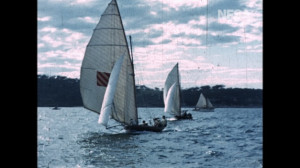
"Semi-professional documentary made in a romantic style as a tribute to Sydney Harbour and the different types of vessels that cruise on it." NFSA.
"JAMES A. SHERLOCK, S.A.C, Sydney, Australia, with his "To the Ships of Sydney," is the winner of the grand prize of $200 in the American Cinematographer's 1937 International amateur competition for 8mm and 16mm films. Under the terms of the gift of $100 in merchandise by Bell and Howell, to go to the maker of the film which in the opinion of the judges was the best in photographic technique of those films made entirely with Bell and Howell cameras, the man Down Under automatically comes in for a second award." American Cinematographer, Jan. 1938, 26.
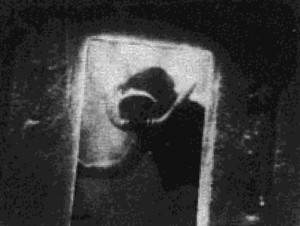
"Tobermory Shipwrecks provides some good views of sunken ships in the Tobermory region, located at the northern tip of the southern Ontario peninsula that separates Lake Huron from Georgian Bay. Much of the underwater photography is well done, and the producer gives tips on underwater photographic equipment and how to use it" PSA Journal, Sept. 1965, 51.
"The Toilers, a 150 ft. Kodacolor reel made by Arthur G. Greaves, demonstrates the continuity possibilities of Kodacolor, a much neglected aspect of amateur color movies. Men at work — in the harbors, along the seacoast and inland, caring for flocks and harvesting grain — is the motif of the picture, relieved by a few glimpses of men and children at play. The picture is distinguished by beautiful photography of consistent quality and by a smooth succession of moving compositions in color. These qualities, combined with a clear continuity, give the film much more unity than is usual with Kodacolor reels. This is one of the all too few Kodacolor films that may be viewed as a subject possessing an artistic purpose as a whole, rather than as a series of separate scenes and sequences. Its chief color triumph is, perhaps, in the scenes of the harvesting against the background of fields of golden grain." Movie Makers, Dec. 1931, 658.
"Coastal people, places and scenery between Vancouver Island and the mainland. Includes footage of Indian villages, pictographs, birds and wildlife, logging operations, other vessels, etc. One sequence shows a Kelly raft of aviation spruce being broken up; another shows logs being unloaded from the log barge 'Monongahela' (formerly the ship 'Balasore', whose figurehead is shown sitting on shore). The B.C. Packers cannery at Quathiaski Cove is shown. Troops arrive at Nanaimo from Vancouver on the 'Princess Victoria' and parade through the streets" British Columbia Archives.
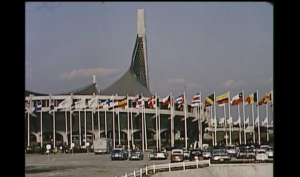
"The Tokyo Olympics, 1964 takes us to Tokyo and the Olympic games and provides us with a ringside seat for the numerous events that composed this athletic activity. Bad weather cannot be helped in a work of this kind, but the results in this picture did not suffer because of any inclement weather. For cut-aways we see the Emperor of Japan in his box, the smiling faces of the Orientals in the audience, and even an occasional glimpse of the cold drink hustlers charging 50 yen for a bottle of Coca Cola" PSA Journal, Sept. 1965, 51.
"Brickett Bridge, Andover Maine was built in 1871 of native spruce lumber. It served its purpose well until 1948 when it was replaced with steel and concrete." oldfilm.org
Total Pages: 299